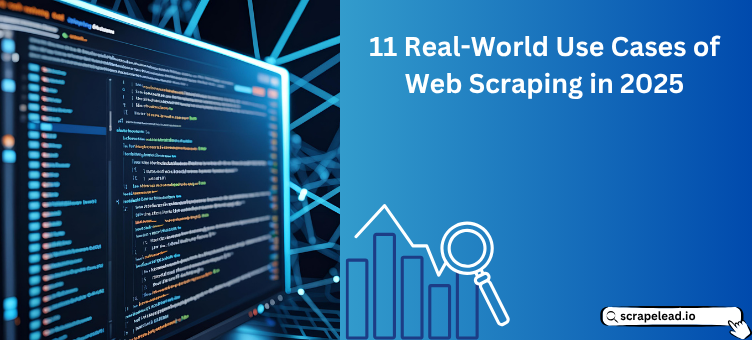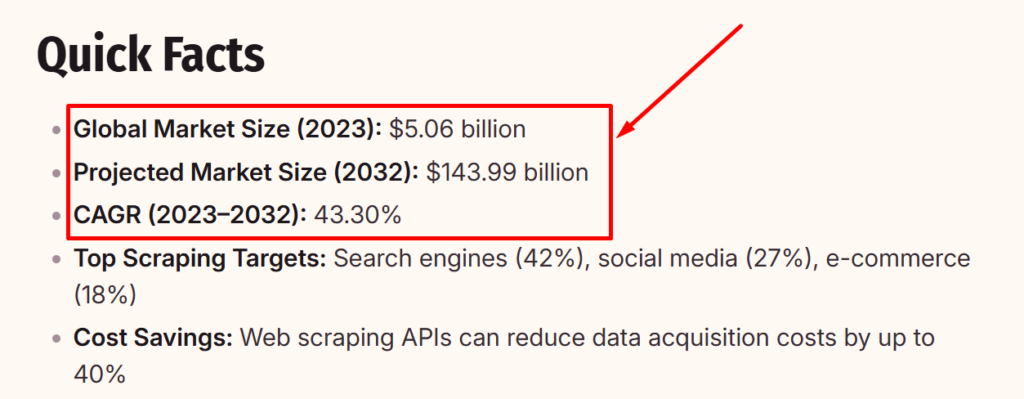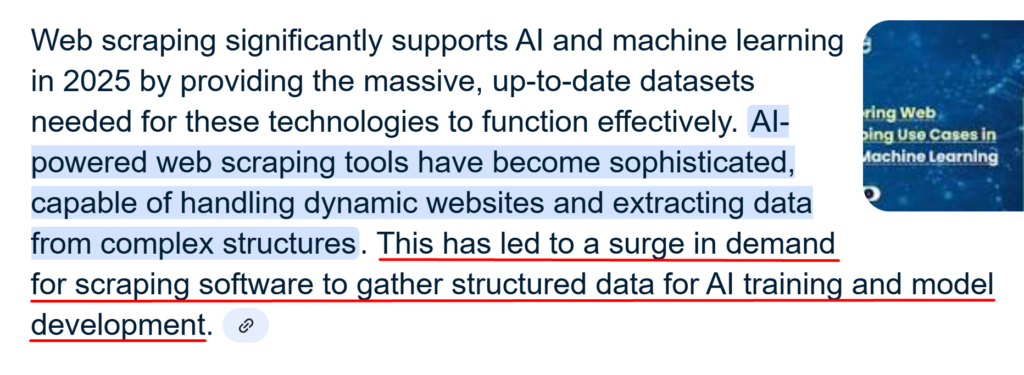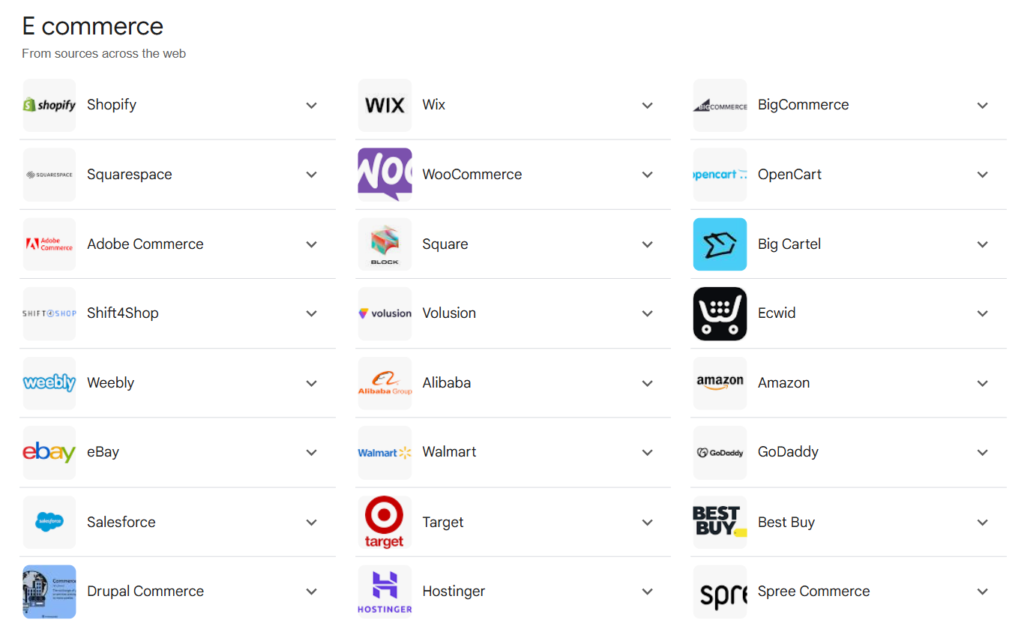
11 Real-World Use Cases of Web Scraping in 2025
The global web scraping software market is currently experiencing significant growth, with a projected increase from $5.06 billion in 2023 to $143.99 billion by 2032.

And before you dismiss this as ‘just a trend’, just know that it will not pass. This so-called ‘trend’ has already taken root in the business world and has now become a fundamental shift in how successful businesses gather intelligence, make decisions, and stay ahead of the competition.
Let’s now address the primary question here: Why now?
You see, data-driven decision-making is no longer optional. With over 65% of organizations now utilizing web scraping to build datasets for AI and machine learning applications, companies that fail to catch up with these capabilities risk falling behind.

Because here’s the thing: The businesses winning today are those that can gather real-time market intelligence, track competitors automatically, and turn web data into actionable insights.
Now, in this guide, we have one goal: to cover top practical, high-impact web scraping applications in 2025. Each one represents a proven opportunity to increase revenue, reduce costs, or gain competitive advantages that traditional data collection methods simply can’t match.
Let’s jump right into it. But first:
Why Does Web Scraping Matter?
Web scraping, also known as data scraping, offers several benefits. You see, unlike traditional data collection methods, which involve manual research, expensive market reports, or limited API access, web scraping shifts the script by offering real-time insights at massive scale.
While a human researcher might analyze dozens of competitor websites in a week, automated scraping can monitor thousands of data points every hour.
Another key reason is the competitive advantage that web scraping provides. Just think about it: When your pricing team spots competitor changes within minutes, not weeks, you can respond faster than anyone else in your market.
Web scraping supports AI and machine learning efforts, which is the most significant development for 2025. These technologies require massive and up-to-date datasets to perform effectively. But because their value is far more beneficial, it’s worth investing in web scraping for them.

Now let’s just jump straight into:
Top Web Scraping Applications of 2025
1. Monitoring Social Media Trends
Objective: To understand what people are talking about and feeling on social media platforms.
Data Sources:
- Twitter (X)
- Quora
Benefits:
- Helps businesses understand customer opinions about their products and services.
- Shows what topics people care about most.
- Helps predict trends before they become popular.
- Guides marketing campaigns and content creation.
ScrapeLead Scrapers that Can Help:
2. Dynamic Pricing and Competitive Monitoring
Objective: To allow businesses and savvy shoppers to track how prices change on different websites so they can find the best deals or set competitive prices.
Data Sources:
- Online shopping websites like Amazon and eBay.
- Retail store websites and apps.
- Price comparison websites.
- Discount and coupon websites.
- Auction sites and bidding platforms.
- Manufacturer websites and official stores.
Benefits:
- Helps shoppers find the lowest prices for products they want.
- Allows businesses to stay competitive with their pricing.
- Tracks price trends and seasonal changes.
- Identifies the best times to buy or sell products.
- Helps with inventory management and stock decisions.
- Saves money for both businesses and consumers.
ScrapeLead Scrapers that Can Help:
3. Finding Potential Customers (Lead Generation)
Objective: To allow businesses to find people or other companies who might be interested in buying their products or services.
Data Sources:
- Business directory websites and yellow pages.
- LinkedIn profiles and company pages.
- Real estate websites and property listings.
- Job posting sites and career websites.
- Professional association websites.
- Local business listing websites.
Benefits:
- Find new customers without expensive advertising.
- Build email lists for marketing campaigns.
- Identify potential business partners or suppliers.
- Expand into new markets and locations.
- Save time on manual research and prospecting.
- Increase sales and revenue opportunities.
ScrapeLead Scrapers that Can Help:
4. Collecting Real Estate Information
Objective: To allow real estate agents, investors, and buyers to gather information about property prices, features, and market trends.
Data Sources:
- Property listing websites like Zillow, Airbnb, Apartments.com, Realtor.com, e.t.c.
- Real estate agent and broker websites.
- Government property record databases.
- Rental websites and apartment listing sites.
- Property auction and foreclosure websites.
- Local housing authority and permit websites.
Benefits:
- Helps buyers find properties that match their criteria.
- Allows investors to identify profitable investment opportunities.
- Assists agents in pricing properties competitively.
- Tracks neighborhood trends and property value changes.
- Provides market analysis to support informed decision-making.
- Saves time searching through thousands of listings manually.
ScrapeLead Scrapers that Can Help:
5. Analyzing Job Markets
Objective: To help job seekers, employers, and researchers understand employment trends, salary ranges, and skill requirements in different industries.
Data Sources:
- Job posting websites like LinkedIn, Indeed, and Glassdoor.
- Company career pages and hiring websites.
- LinkedIn job listings and professional profiles.
- Government employment and labor statistics websites.
- Salary comparison and review websites.
- Freelance and gig economy platforms.
Benefits:
- Helps job seekers find opportunities that match their skills.
- Shows employers what salaries competitors are offering.
- Identifies which skills are most in demand.
- Tracks employment trends and market changes.
- Assists career planning and education decisions.
- Improves hiring strategies and talent acquisition.
ScrapeLead Scrapers that Can Help:
6. Gather Product Reviews, Customer Reviews, and Opinions
Objective: Businesses want to understand what customers really think about products and services by collecting and analyzing online reviews.
Data Sources:
- E-commerce websites like Amazon and eBay.
- Review platforms like Yelp and TripAdvisor.
- App stores and software review sites.
- Restaurant and hospitality review websites.
- Product manufacturer websites.
- Social media posts and comments about products.
Benefits:
- Helps businesses improve their products and services.
- Identifies common customer complaints and issues.
- Shows what features customers value most.
- Guides product development and innovation.
- Improves customer service and support strategies.
- Helps consumers make better purchasing decisions.
ScrapeLead Scrapers that Can Help:
7. Training Smart Computer Programs and AI Models
Objective: The main goal is to collect huge amounts of text, images, and other information from websites to teach artificial intelligence programs how to be more thoughtful and helpful.

Data Sources:
- News websites and online articles.
- Social media posts and comments.
- Wikipedia pages and educational sites.
- Online forums and discussion boards.
- Product reviews and descriptions.
- Books and research papers available online.
Benefits:
- Makes chatbots like ChatGPT smarter and more helpful.
- Helps computers understand human language better.
- Allows AI to answer questions about almost any topic.
- Improves translation between different languages.
- Makes voice assistants more accurate.
- Helps create better recommendation systems for movies, music, and products.
8. Product Feature and Specification Comparison
Objective: To gather detailed product information (like size, weight, features, and price) from different brands so shoppers or businesses can compare and choose the best option.
Data Sources:
- Manufacturer websites that list official product specs.
- E-commerce platforms (Amazon, Best Buy) where product details and technical tables are shown.

- Tech review blogs and sites that break down pros, cons, and specs side by side.
- Online retailer sites (Newegg, Walmart) with product descriptions, dimensions, and photos.
- Specialty aggregator sites that consolidate specs from multiple makers.
Benefits:
- Presents all key specs in one place for easy side-by-side comparison.
- Helps shoppers quickly compare products.
- Identifies when a manufacturer updates a spec (for example, “Now this laptop has 16GB RAM instead of 8GB”).
- Saves time by eliminating the need for manual copy and paste from multiple websites.
- Guides businesses in choosing the right equipment or parts by comparing performance metrics.
- Enables retailers to create interactive comparison widgets on their own sites.
ScrapeLead Scrapers that Can Help:
9. SEO and Keyword Research
Objective: To discover which words and phrases people type into search engines and see how top websites rank, so businesses can optimize their own pages to show up higher in search results.
Data Sources:
- Google search results pages (titles, meta descriptions, and ranking positions).
- Bing search results pages (page titles, URLs, and snippets).
- Keyword suggestion tools that list related search phrases people type.
- Competitor websites (blog posts, product pages) to see which keywords they use.
- SERP features (like “People also ask” boxes or featured snippets) on Google and Bing.
- Local search results (Google Maps listings) for location-based terms.
Benefits:
- Identifies high-volume search terms that bring traffic.
- Shows current ranking positions of your site versus competitors’ sites.
- Finds content gaps where your competitors rank for keywords you don’t have.
- Helps craft blog posts or product pages around the exact words people search for.
- Enhances website visibility, resulting in increased traffic and potential customers.
- Enables tracking of keyword ranking changes over time to measure SEO success.
10. News Aggregation and Real-Time Alerts
Objective: To collect breaking news headlines and articles from multiple sites as soon as they publish, so traders, analysts, and PR teams can react fast to new information.
Data Sources:
- Major news outlets that post financial, business, and general news headlines in real-time.
- Google News search results for specific topics, companies, or keywords.
- Niche industry blogs and specialized sites.
- RSS feeds provided by news websites for instant updates.
- Press release distribution sites for direct corporate announcements.
Benefits:
- Delivers instant notifications when significant news breaks.
- Allows investors or traders to make timely buy/sell decisions based on the latest headlines.
- Helps PR teams monitor brand mentions and respond promptly to both negative and positive coverage.
- Builds a centralized dashboard or newsletter that updates automatically with fresh headlines.
- Tracks sentiment trends by collecting headlines tagged as positive or negative.
- Reduces manual checking of multiple sites by automatically aggregating all relevant news.
ScrapeLead Scrapers that Can Help:
11. Cybersecurity Threat Intelligence and Dark-Web Monitoring
Objective: To monitor public paste sites, forums, and dark-web marketplaces for leaked credentials, malicious tools, or early signs of hacking, so security teams can defend before damage happens.
Data Sources:


- Dark-web marketplaces where stolen data or malware is sold.
- Public code repositories (GitHub, GitLab) for accidentally exposed secrets or API tokens.
- Security forums and exploit databases (ExploitDB, Reddit’s r/netsec) that discuss new vulnerabilities.
- Threat intelligence blogs and websites for breaking security news.
Benefits:
- Alerts security teams if employee or customer credentials appear in leaks, allowing immediate password resets.
- Identifies new malware, ransomware, or exploit kits being sold on dark-web markets for faster defense measures.
- Finds exposed API keys or tokens in public code so companies can revoke them before misuse.
- Monitors hacker chatter on forums to learn about planned attacks or zero-day vulnerabilities.
- Provides early warning of data breaches, giving time to notify users and comply with regulations.
- Helps enterprises build threat intelligence databases to improve future security posture.
Web Scraping Isn’t Just a Tech Trend. It’s a Business Advantage
If you’ve read this far, you already understand that web or data scraping is more than just trendy terms.
Remember, the ability to access and act on real-time web data could be what sets your company apart from the competition, whether you’re a startup looking to grow or an established company looking to stay ahead. And the good news is that you can do it without knowing how to code or hiring a whole development team.
With ScrapeLead, data scraping is made easy, quick, and stress-free.
No headaches from coding. Simply clear, usable data from the websites that are most important to your company.
So, are you prepared to transform insights into progress?
Try ScrapeLead now and see what your business can do with the right data at your fingertips.
FAQs
Why might a business use web scraping to collect data?
To:
- Automate the data collection process.
- Get real-time competitive intelligence.
- Collect comprehensive market insights.
- Power AI and machine learning initiatives.
- Stop manual data collection, which is time-consuming and tedious.
What is the best tool for scraping the internet?
The best web scraping tool for you will depend on how you plan to use it, what technical requirements you have, and how much you need to grow. If you want a tool that can do all of the things listed above and more, Scrapelead is the best choice.
Is there a difference between web scraping and web crawling?
Web scraping focuses on extracting targeted data from specific web pages, whereas web crawling systematically explores and indexes entire websites or sections of the internet. Go here for a detailed breakdown of the two.
Is web scraping legal in 2025?
Yes, if done ethically. Ensure you avoid collecting personal data, respect website terms, and use scraping tools responsibly.
What industries benefit the most from web scraping in 2025?
E-commerce, real estate, finance, travel, and market research; these sectors rely heavily on scraped data for pricing, trends, and insights.
Related Blog

Which Review Scraper Is Best for Your E-commerce Business?
Want a simple way to start scraping reviews? Learn how to grab real customer feedback and make smarter product decisions fast.

How to Scrape Social Media Without Coding (2025 Guide)
Discover how to collect social media data effortlessly with no-code tools in this 2025 guide.

Lead Generation Cost in 2025: Are You Ready to Pay Up?
Leads keep your business alive! See what they cost by industry & channel, and how to cut costs without losing quality.
